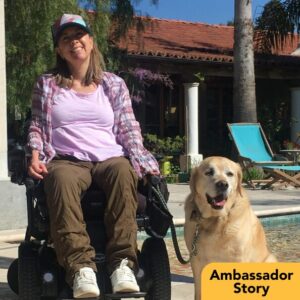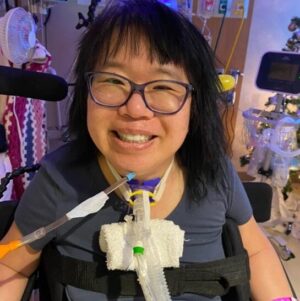Theo St. Francis has been exploring the world of body-connection since his 2013 C6 spinal cord injury at the start of his Mechanical Engineering studies at MIT. Having been opened to a whole new way of being through his practice of Pilates, he is working to make mindful movement a standard in neuro-recovery.
He has been fundraising with Help Hope Live for intensive physical therapy and cutting-edge rehabilitation since June 2014.
What would it feel like to be able to just jump – and start flying? Well, I don’t know, and the birds won’t say, but I’ll bet the experience would be indescribable, and ‘indescribable’ is something I know.
Since my body has been partially paralyzed for almost three years, it is understandable that I’ve forgotten what some things feel like. That’s how our plastic, use-it-or-lose-it brains work: the subconscious patterns of walking and standing, of dancing without thinking, don’t get reinforced when the muscular connection isn’t present.
This is part of the overwhelming feeling of loss that accompanies a paralyzing injury to the spinal cord (SCI) because, in some ways, one’s sense-of-self fades with the loss of those patterns. When the physical manner by which you relate to the world is changed, the emotional nature of that relationship is changed as well.

“One’s sense-of-self fades” with the loss of familiar physical patterns
A flash…
One day in May, I noticed something strangely familiar during my regular 3-hour neuro-Pilates workout. We prepared to use a trapeze table, or trap table, a piece of Pilates equipment with a wooden bar hanging by springs from a frame. For some time my trainer and I had been stumped – I had developed feeling in my hip muscles while kneeling, yet when on my feet, my system turned off.

An example of a Pilates trapeze table
On that afternoon, we incrementally raised my knees on foam wedges until my feet were on the floor; with my hands on table-uprights, the vertical bars at each end of the trap table, and an arc blocking my knees, I lowered myself into a squat and, for the first time ever, pressed back up to standing!
“Wow, so this is what it feels like to connect to my legs!” was my first thought, and after the third unsupported squat, I felt a visceral excitement and had a fleeting image of letting go of the trap table, turning toward the door, and just walking outside. It was as if my body just remembered its own capability. Can you imagine? It was glorious. Indescribable!
Progress has been from many directions
Since my injury in Boston Harbor in August 2013, I have received care from experts in hospitals, rehab centers, SCI CrossFit gyms, Eastern medicine enclaves, and Pilates studios. I’ve learned from a variety of therapists with different but overlapping skills and set up equipment in our home to extend workouts throughout the day and evening. I feel very fortunate to have found the talented members that comprise my rehabilitation team.
Throughout this extensive process, the unflagging assistance of my family members has been invaluable. Their efforts– from the early days in the hospital to working with the medical staff and learning the techniques that would help me in daily activities to seamlessly managing logistics until I could do so myself–have been essential, both in the acts themselves and in the time and space they’ve created for me to pursue my therapies with rigor.
Also significant in my recovery, has been working with the Neuro-Kinetic Pilates specialists on Maui. In my most recent sessions there this June, I was able to find my own lateral hip strength in a stagger-stand position. I have been working to achieve this stability since I first muscularly connected my torso 18 months ago. It is immensely satisfying to finally achieve this result.

“It is immensely satisfying” to regain physical ability at any level after injury
While all of this bodily improvement was happening, something even more significant occurred between my sessions: independence…in two ways.
For the first time really ever, this 21-year-old lived completely by himself. In truth, it was for less than a week – friends and family visited me on the island at other times – but, even so, after all I was told by doctors about the purported permanence of my paralysis, to be able to thrive on my own was a turning point in my recovery.
I am quite aware that this independence has only been achievable through the incredible support of so many over the last few years, especially all of those who have helped me and my parents with fundraising and driving to therapy appointments. My family is sincerely grateful for the support of so many people through Help Hope Live that make it possible for me to pursue the most effective recovery treatments. This sense of wonder for the gifts of support is also indescribable.
Diving deep
The second form of independence was very different. The day I fractured my C6 vertebra was less than a week before my first practice on MIT’s Varsity Swim Team, to which I’d been recruited as a backstroker. Even with all my progress since, I still require a hip-float to stay above water. That’s fine; except when I was in Maui swimming above scores of fish, coral, and turtles along the reefs 10 feet below. There was no way I was going to forgo some of the world’s premier reef-level snorkeling by being bound to the surface. Confident in how my improved core strength enabled me to control my breathing, I unclipped the float, handed it to my friend, and madly used my arms to fight the saltwater’s buoyancy. After some practice, I became comfortable descending over 20 feet and, on my last day on the island, I swam floatless for a full 40 minutes.
To me, going floatless is about far more than being eye-to-eye with Reef Triggerfish. It’s about stripping away the support I think I need to discover my true abilities, and in so doing, rediscovering that sense of self. It’s about diving deep into a fear, a perceived limitation, and returning to the surface with new appreciation for what is possible.
Through these moments of ecstatic, indescribable joy I can happily see that this truly may be the beginning of the final stage of my overcoming.

Theo pursues and relishes “moments of ecstatic, indescribable joy”
Last fall, Theo St. Francis presented his first workshop and co-wrote a textbook on Pilates for SCI with his trainer, Stephanie Behrendt, and they plan to expand the curriculum (zebrafishneuro.com for more). Theo has also found his home regimen to be vital in giving him space to explore, so he is developing an at-home protocol for individuals who have endured a spinal injury to understand their bodies in new ways. He absolutely intends to return to MIT when he feels his body is ready. Connect with him on his website, Facebook (fb.com/THEOvercoming1 or personal), and Instagram.











